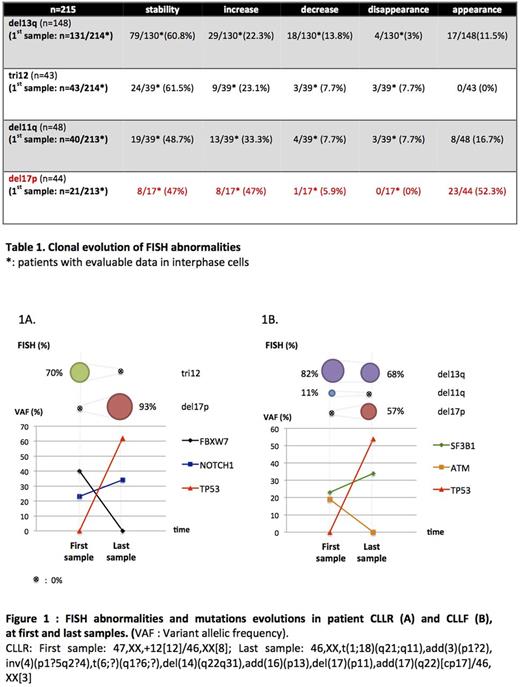Abstract
CLL has a heterogeneous genetic landscape, and is characterized by recurrent structural abnormalities. In the era of personalized medicine, it is important to understand the role of clonal and subclonal abnormalities, their dynamic evolution and their impact on disease relapse.
We longitudinally analyzed 215 CLL. They benefited from karyotype (K) and FISH with the 4 classical probes, and IGHV status. NGS was carried out in some cases on a MiSeq® platform (Illumina) using the CLL MASTER PLUS kit, to determine the status of TP53, ATM, BIRC3, NOTCH1, XPO1, SF3B1, MYD88, FBXW7 and POT1 . Statistical analyses were performed with the CHI2 test.
The median number of samples per patient (pt) was 2 (range 2-8). The median time between the 1st and the last sample was 44 months (range 3-228). Out of 208 pts with available data, 164 (79%) were untreated at 1st sample. Regarding pts with successful K in 1st and last samples (n=162), there were more abnormal K (64 vs 78%, p=.005), more complex (C) K (20 vs 35%, p=.003), and more high CK (9 vs 20%, p=.007) in the last sample. Using FISH, a median of 1 abnormality/patient was observed (range 0-3). Regarding pts with the 4 probes performed in 1st and last sample (n=212), there were more pts with 3 abnormalities (0.5 vs 6%, p=.002) in the last sample, including more del17p (10 vs 20%, p=.004).
In pts with del13q, it was observed in the 1st sample in 88% of cases; the median % of cells del13q+ was 66 (range 5-98). The % of cells del13q+ could remain stable, increase (median 1.8 fold, range 1.3-7.9), or decrease (median 0.6 fold, range 0.2-0.6). In 4 pts, subclonal del13q (range 3-10%) was lost, including 1 without treatment. Del13q appeared in 17 pts. Tab 1.
When present, tri12 was always detected in the 1st sample; the median % of cells tri12+ was 65 (range 3-86). The % of cells tri12+ could remain stable, increase (median 1.7 fold, range 1.3-3.3), or decrease (median 0.5 fold, range 0.4-0.6). Tab 1. Tri12 disappeared in 3 pts: i. In 2 pts tri12 was present in a low % of cells (3 and 6%); ii. for pt CLLR, tri12 was the sole cytogenetic abnormality (70%), with FBXW7 and NOTCH1 mut (VAF 40%, 23%). At relapse after FCR treatment, tri12 totally disappeared with FBXW7, NOTCH1 mut remained stable (VAF 34%), and a new clone with high CK appeared with del17p (93%) and TP53 mut (VAF 62%). Fig 1A. IGHV were unmut in the 3 cases.
In pts with del11q, it was present in the 1st sample in 83%, the median % of cells del11q+ being 58% (range 5-97). The % of cells del11q+ could remain stable, increase (median 1.8 fold, range 1.5-5.1), or decrease (median 0.33 fold, range 0.31-0.35 fold). In 8 pts, del11q appeared in a sub-clone, following treatment in most cases (7/8). (Tab 1) In 3 pts, del11q disappeared after treatment (RF or RFC), and at relapse, a new clone with del17p appeared: i. del11q was subclonal for 2 pts: a. for pt CLLA, we observed del11q (11%), tri12 (51%), and FBWX7, POT1 and ATM mut in the 1st sample (VAF 45%, 34%, 6%); at relapse, tri12 (93%) as FBXW7 and POT1 mut (VAF 48%, 29%) were still present, and del17p (17%) appeared with TP53 mut (VAF 16%). ATM mut was detected with a VAF at 0.9%. b. for CLLF, del11q (11%) was present with del13q (82%), ATM and SF3B1 mut (VAF 19%, 23%). At relapse, del13q (68%) was observed with del17p (57%), SF3B1 and TP53 mut (VAF 34%, 54%) Fig 1B; ii. for CLLB, del11q (41%) was the sole abnormality at diagnosis. At relapse, a high CK appeared with del17p (65%) and TP53 mut (VAF 10%). For the 3 pts, IGHV were unmut, and TP53 mut could be detected a posteriori in the 1st sample with a VAF < 1%.
More than half of del17p (23/44 (52%)) appeared in the follow up. The median % of cells del17p+ in 1st sample (n=21) was 53% (range 7-93). The % of cells del17p+ could remain stable, increased (median 1.9 fold, range 1.3-5.8), and decrease. No case of disappearance was observed at relapse. Tab 1.
We have shown that CLL acquire CK and a high number of FISH abnormalities during progression, in particular del17p. Whereas tri12 is never acquired at relapse, del13q, del11q and del17p can appear in the evolution of the CLL more frequently after treatment than during natural evolution. Whereas del17p always remains at relapse, del13q, tri12, and del11q can disappear after treatment, even if each patient has his own trajectory. Gene mutations could also be maintained, acquired or lost. The future challenge may be to characterize each individual tumor, at both cytogenetic and molecular level, to predict dynamic evolution in order to propose a matching therapy.
Leblond: SERVIER: Honoraria, Membership on an entity's Board of Directors or advisory committees; GILEAD: Honoraria, Membership on an entity's Board of Directors or advisory committees, Speakers Bureau; JANSSEN: Honoraria, Membership on an entity's Board of Directors or advisory committees, Speakers Bureau; BMS: Honoraria; ABBVIE: Honoraria, Membership on an entity's Board of Directors or advisory committees, Speakers Bureau; ROCHE: Honoraria, Membership on an entity's Board of Directors or advisory committees, Speakers Bureau; NOVARTIS: Honoraria, Membership on an entity's Board of Directors or advisory committees.
Author notes
Asterisk with author names denotes non-ASH members.


